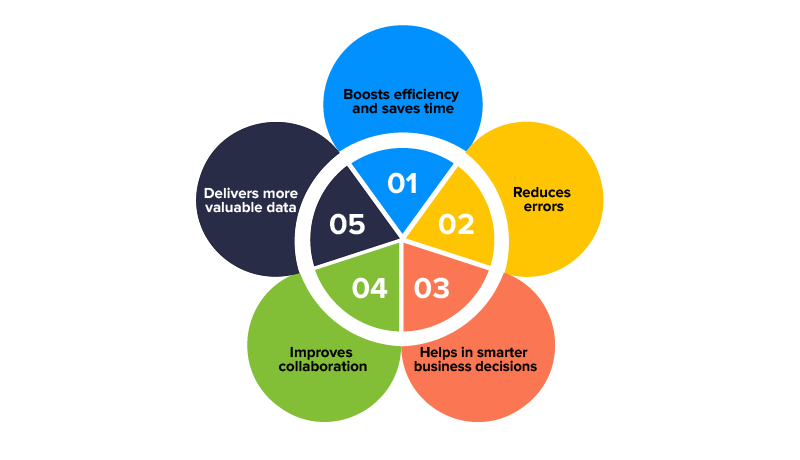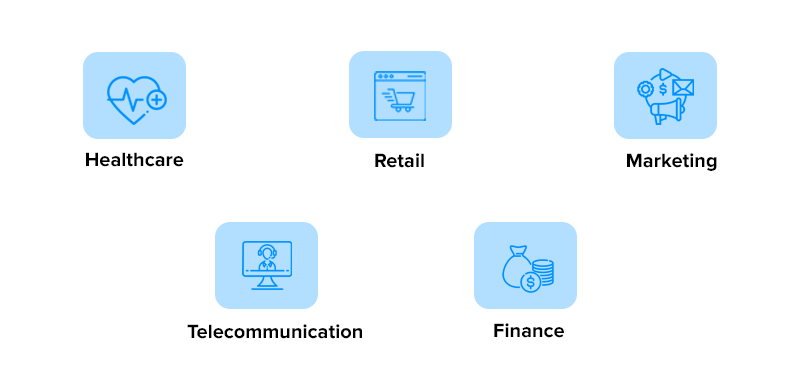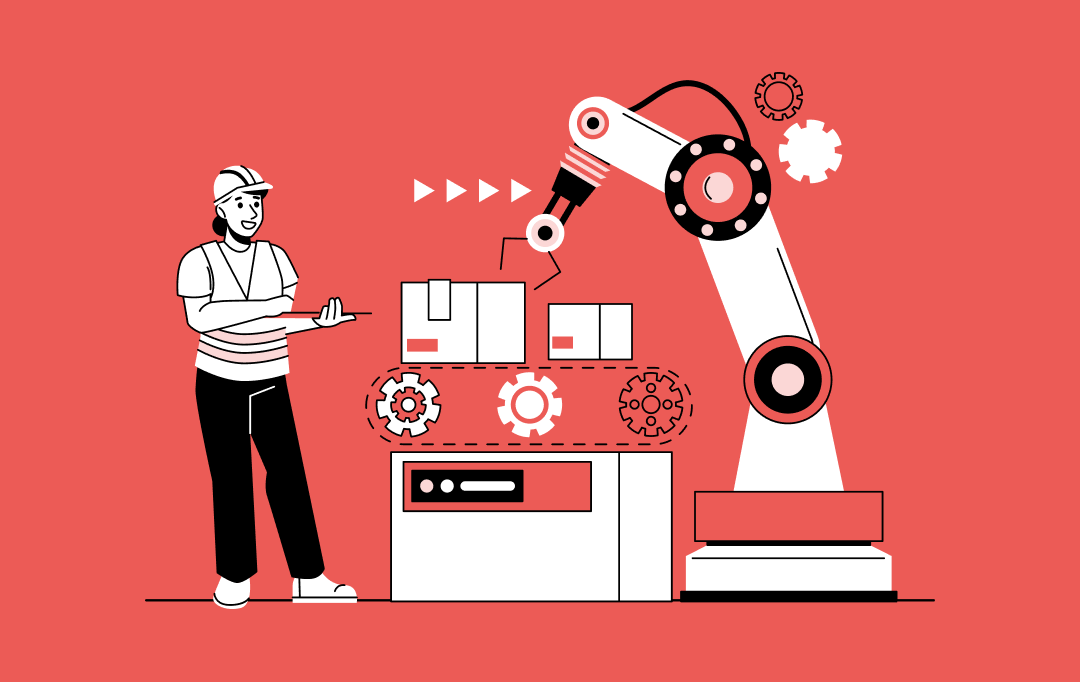Every business generates tons of data every day. A typical business uses several on-premise systems and hundreds of applications for storing enterprise data. Thus, data is one of the most crucial components using which today’s businesses are thriving.
Now, while businesses are producing huge amounts of data every second, that data is of no use if it is not adequately managed and integrated. Tons of data can get piled up and ultimately become unmanageable. And this is where data integration comes into play.
The process has emerged as one of the primary components in the overall data governance process. With the rising need to share existing data promptly, enterprises are employing data integration with increasing frequency.
Data integration processes typically involve a few common elements, including a master server, a network of data sources, and users accessing data from the master server. Working from this one data set allows businesses to make better decisions, drive better customer experiences, and align departments to work better together. Modern startups and enterprises rely on advanced solutions such as Enterprise data warehouse, data lakes and software app development to level up their data.
So, without further ado, let’s understand the concept of data integration and why it’s the next big thing for enterprises.
What is data integration?

Data integration is the process of combining data from different sources into a single and unified view. Integration begins with the ingestion process and uses the ETL approach that extracts, transforms, and loads data from different sources into a unified view. Data integration ultimately enables analytic tools to produce actionable, effective business intelligence.
For instance, customer data integration involves extracting information about each customer from disparate business systems such as sales, marketing, and accounts, which is then combined into a single view of the customer to be used for reporting, analysis, and customer service.
Data integration can consolidate all kinds of data – structured, unstructured, batch, and streaming – to do everything from basic querying of inventory databases to complex predictive analytics.
Now that we know what is data integration, let’s get into the benefits of using data integration in your business.
Why is data integration important?

The demand for big data integration is continually growing.
As reported by Global News Wire, the data integration market is estimated to reach USD 19.6 billion by 2026 from USD 11.6 billion in 2021, growing at a CAGR of 11%.
Whether an organization is looking to merge databases between partners or a government department is looking to eliminate data silos between departments, data integration systems can play an essential role in mitigating tedious data manipulation methods.
So, on that note, here are a few advantages of using data integration solutions for your business.
1. Boosts efficiency and saves time: When a company integrates techniques like data integration into their business processes, it significantly cuts down the time it takes to prepare and analyze that data. The automation of unified views also eliminates the need for gathering data manually.
The time saved on these tasks can be used for analysis and execution to make an organization more productive and competitive.
2. Reduces errors: There’s a lot to keep up with when it comes to a company’s data resources. To gather the data manually, employees must know every location and account they might want to explore. Plus, they must install all the necessary software before they even begin to ensure their datasets will be accurate and complete. In case, a data repository is added, and that employee is unaware, they will have an incomplete dataset.
When data integration is in place, your employees have access to the most accurate and real-time data whenever needed. It also reduces tedious manual work and data manipulation, thereby minimizing errors.
3. Helps in smarter business decisions: Data integration allows transparent business processes within the enterprise. Data integration systems give the flexibility to use data in different internal systems in whatever way the businesses want. This allows them to understand data clearly. Therefore, any decision regarding business processes can be made quickly and smartly.
4. Improves collaboration: Employees in every department – and sometimes in disparate physical locations – need access to the company’s data for business projects. Additionally, employees in almost every department are improving and generating data that the rest of the business needs.
By integrating data, everyone can access a unified view of the data from the entire organization. This improves collaboration and unification across the organization.
5. Delivers more valuable data: Data integration process improves the value of a business’ data over time. As data is integrated into a centralized repository system, quality issues are identified and improvements are implemented, resulting in more accurate data — the foundation for quality analysis.
Techniques used for data integration
The need for big data integration arises when data is coming in from external as well as internal sources. This is achieved using different types of data integration techniques, depending on the complexity, disparity, and volume of the data sources.
Let’s get into the different types of data integration techniques one by one and see how they can help improve business intelligence processes.
1. Data consolidation: Data consolidation combines data from different sources to create a centralized data repository. This centralized repository is then used for various purposes, such as data analysis and reporting.
A key factor that differentiates data consolidation from other data integration techniques is data latency. Data latency is defined as the total time taken to retrieve data from different sources to transfer it to the data store.
A shorter latency period means fresher data is available for business intelligence and analysis in the data store.
Depending on the technologies used for data integration and the needs of your business, this latency can range from a few seconds to hours, or even more. However, with advancements in data technologies, it is possible to consolidate data and transfer changes to the destination in near real-time or real-time.
2. Data propagation: Data propagation uses applications to copy data from one location to another on an event-driven basis. Enterprise data replication (EDR) and enterprise application integration (EAI) can be used for data propagation.
While EDR is more frequently used to transfer data between two databases, EAI provides a link for purposes such as business transaction processing between two systems.
3. Data federation: This technique creates a virtual database that consolidates data from various sources. Users then use the virtual database as a single source of truth for all the data in the organization.
In this technique, data abstraction is done to create a uniform user interface for data retrieval and access. As a result, whenever an application or user queries the virtual database, the query is sent to the relevant underlying data source.
In other words, the data is served on an on-demand basis in the data federation.
4. Data warehousing: This type of data integration involves using a common storage area to cleanse, format, and store data. In this technique, data from all applications across an organization is copied to the data warehouse. From here, it can be queried by data analysts.
Querying data on the warehouse instead of the source applications means that analysts don’t have to worry about impacting the performance of the app or software.
Plus, data analysts can view all of the data in a central, single location, which means they can check for data’s accuracy and consistency.
5. Middleware data integration: Middleware data integration involves using a middleware application between source systems and a central data repository. The middleware helps to validate data before sending it to the repository, which could be a cloud data warehouse or a database.
[Also Read: A Complete Guide on Data Science & Analytics for Businesses]
Data integration uses cases in real-world

Integrating data is the first step to uncover its true potential. When companies have all their information in one place, it becomes possible to find the most accurate and important insights within it.
Data integration software is now being used by a majority of industries, majorly including healthcare, telecommunications, and retail. These industries are adopting data integration techniques to improve their business processes and this is what gives them a competitive advantage.
Here are some real use-cases of data integration that show how this technique can help businesses from different sectors and industries.
1. Healthcare: Treating patients requires utmost care and access to their treatment history. Previously, patient data used to be spread across systems, which ultimately compromised care. However, with data integration, hospitals have started integrating as much data as possible into a single comprehensive record. This, in turn, has resulted in improving patient outcomes, elevating health and wellness, and reducing costs.
2. Retail: Retailers deal with tons of data every single day. So, their performance tracking entirely depends on having all the relevant data in one place. Data integration empowers retailers to manage sales, inventory, and other vital metrics within their different outlets and channels smoothly.
3. Finance: The financial industry has started embracing data integration for fraud prevention and detection, measuring credit risk, maximizing cross-sell/up-sell opportunities, and retaining valuable customers.
[Also Read: How Machine Learning Helps in Financial Fraud Detection in the FinTech Industry]
4. Marketing: Marketing is another area where data integration has become important. It involves sending messages to the right audience at the intended time. If things are not finely tuned, marketing campaigns can go south in no time.
Managing information on thousands or potentially millions of consumers is impossible without proper integration channels and tools for data integration. It could lead to disappointing campaigns and wasted marketing budgets. Integrating data is the only way to keep it up-to-date and organized.
5. Telecommunications: Quality customer service is crucial in telecommunications, and for this data integration is important. Integrating data from a variety of sources provides a 360-degree view of company and customer relationships. Issues leading to low customer satisfaction and more customer service requests can be identified and corrected.
Challenges in data integration
Common challenges that data management teams encounter on data integration include unifying inconsistent data silos, keeping up with growing data volumes, and resolving data quality issues. In organizations with global operations, the number and distributed nature of systems that need to be integrated add to the complexity.
Data volumes continue to grow quickly, and this is only going to amplify as IoT develops further and the use of low-cost cloud object storage services rises.
Data integration software is vital for realizing the full potential of all that data, but successfully managing and planning the required integration work is a complicated process.
So, here are a few common challenges that organizations face in building their integration systems:
1. Complex to deploy and use: Getting started with data integration can be an intimidating task. This is especially true for large organizations that have distributed data silos and no single source of truth for data. Enterprises that are looking to make data accessible for everyone need a data integration strategy that ensures data governance and meets security requirements while making the data integration process simple and scalable.
2. Data from newer sources: New systems generate different types of data such as real-time or unstructured data from different sources such as videos, sensors, and IoT devices. Figuring how to quickly adapt your data integration infrastructure to meet the demands of integrating all these data becomes critical for your business. But the volume, speed, and new format of data pose new challenges.
3. Keeping up with data integration: Your task isn’t finished once an integration system is up and running. It becomes vital for the data team to keep data integration efforts at par with best practices and as per the latest demands from the organization and regulatory agencies
4. New data types can be challenging: There are increasing numbers of data types generated by different systems such as IoT devices or sensors. It’s important to have a flexible integration strategy in place to integrate these new and emerging data types. You can then take advantage of the insights you can get from the data coming out of these systems.
How can Appinventiv help with data integration?
The advantages of utilizing data integration within a company are endless. From offering clear insights into business trends and performance across all departments to improving customer experiences, the implementation of data integration can enhance your business’s proficiency.
Speaking of trends, Explore the top 5 trends shaping the future of data infrastructure in 2022 and beyond
At Appinventiv, our highly-experienced team of professionals will help you implement the automated data integration software for your business while taking care of all your data challenges at the same time.
With our expertise, you can create a modern data architecture for your business regardless of the data’s type, format, origin, or location.
So, in case you want to implement data analytics solutions in your business, you can consult and hire our experts. We will have all your needs covered!
FAQs
Q. What is data integration in simple terms?
A. Data integration is the process of consolidating data from disparate sources into a single dataset for a unified view.
Q. How is data integration used?
A. In a typical data integration process, a request is sent by the client to the master server for data. The master server then intakes the required data from both internal and external sources. The data is extracted from sources and then consolidated into a single, unified view. This is served back for the client’s use.
Q. Why is data integration important?
A. Data integration brings together data from different systems and makes it more valuable for your business. It helps your employees work better together and do more for your customers.



10 Use Cases and Benefits of Predictive Analytics in Manufacturing
Are you trying to stay in today’s manufacturing game with that old-school data analytics approach? Not gonna happen, buddy! Think about that old-school grind: manufacturing plant techies had to hustle around, scribbling notes and logging maintenance records by hand. All that manual intervention and hassle led to nothing more than messy data and bad calls.…

10 Use Cases and Benefits of Adopting Predictive Analytics in the Oil and Gas Industry
The oil and gas industry has always been at the forefront of technological advancements, constantly seeking innovative solutions to improve efficiency and maximize output. It is where predictive analytics emerges as a game-changing solution, transforming how companies manage operations, optimize production, and mitigate risks. In the oil and gas sector, where even the smallest oversight…

Data is the new asset in today's digital age, prompting businesses across industries to explore innovative ways to leverage its transformative power and gain a competitive edge. This is where business operational analytics steps in. It has emerged as a game-changer for companies aiming to optimize performance, streamline operations, and make data-driven decisions. By tapping…









